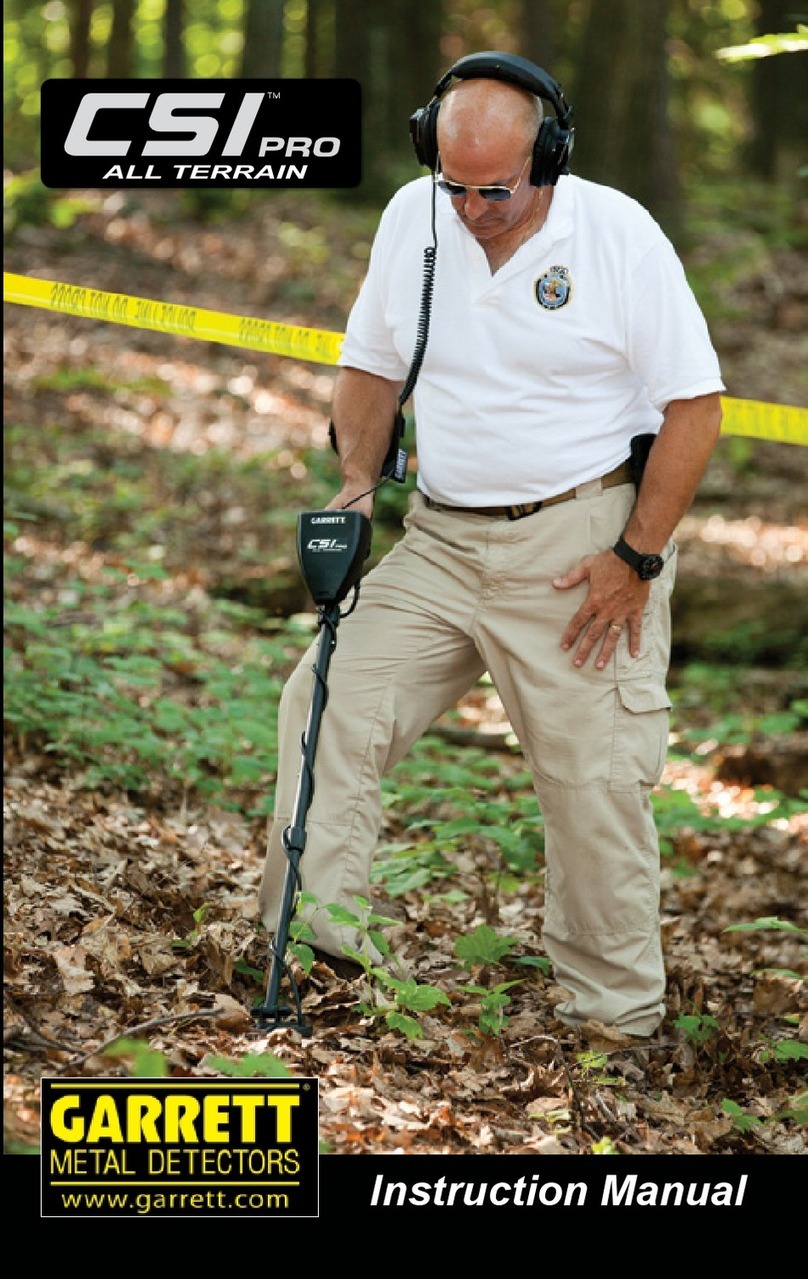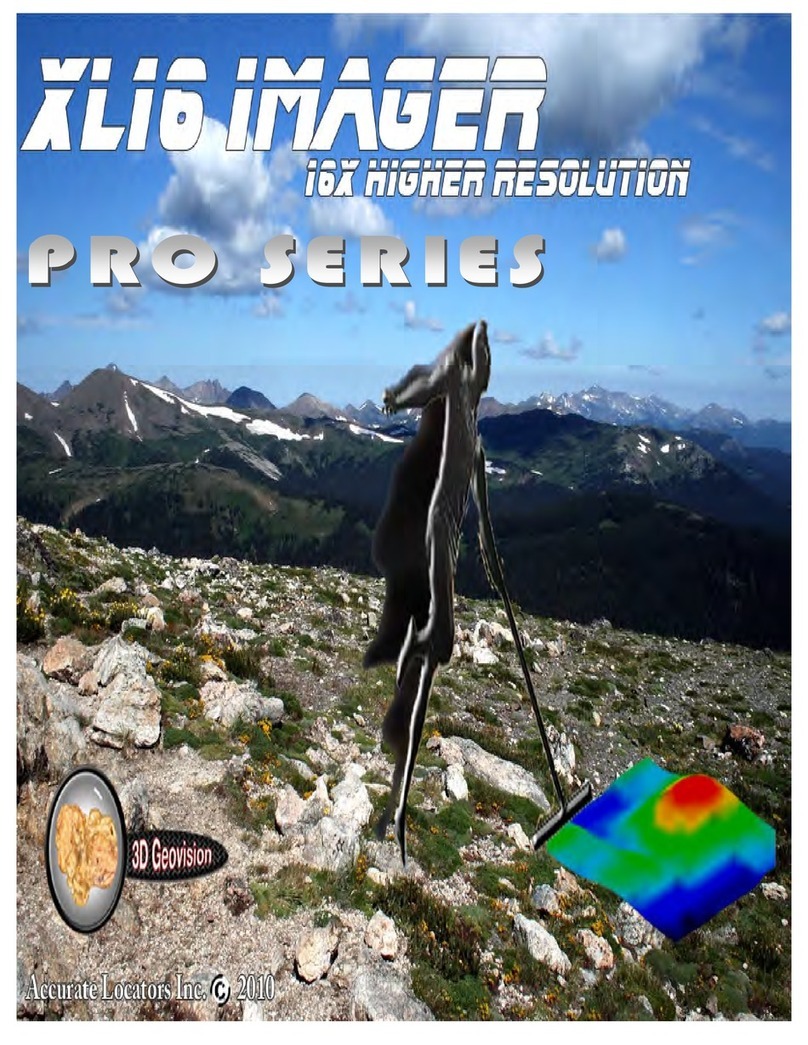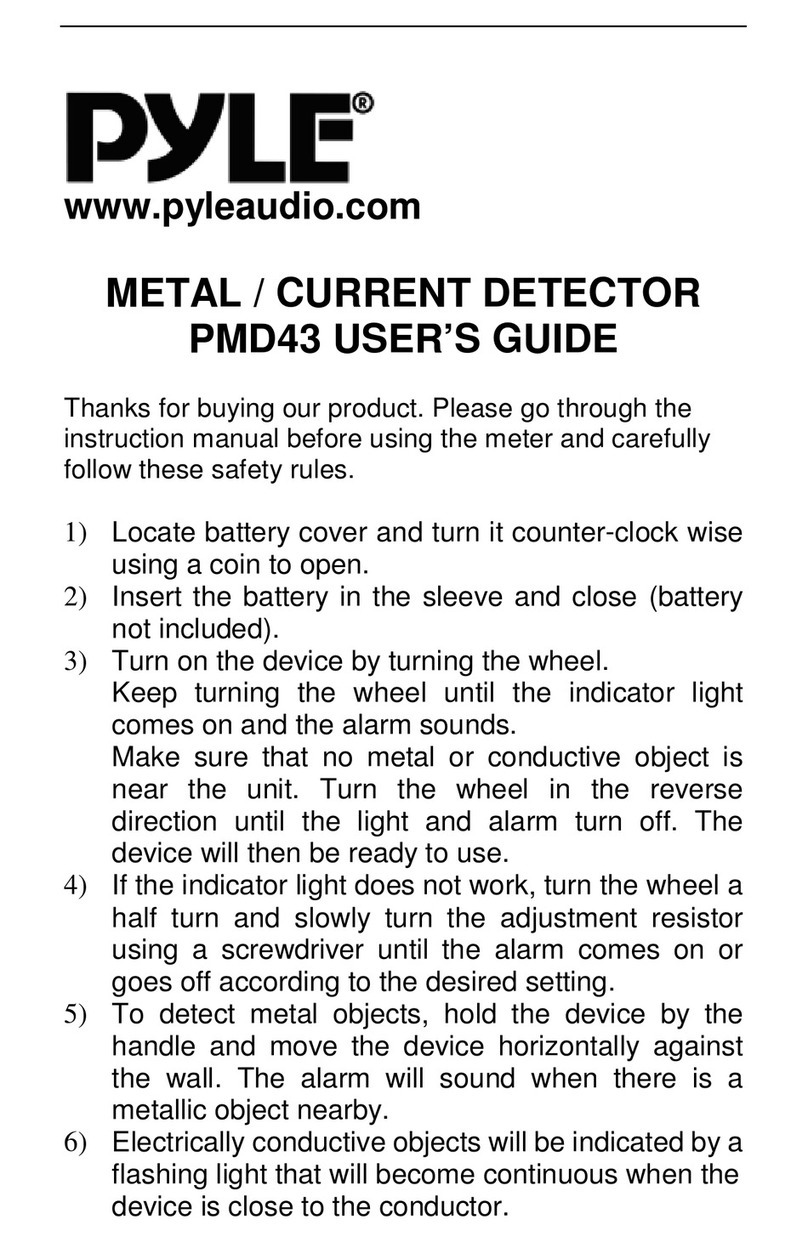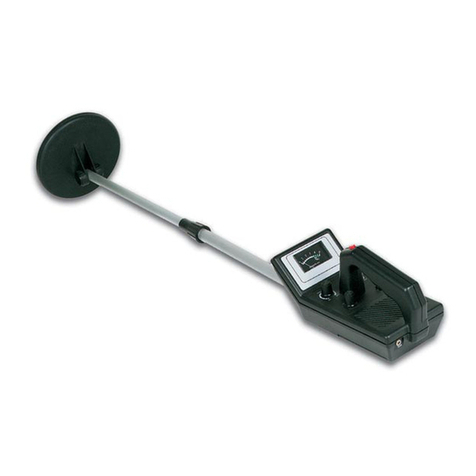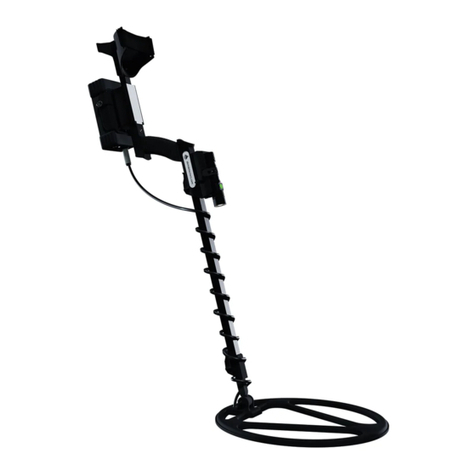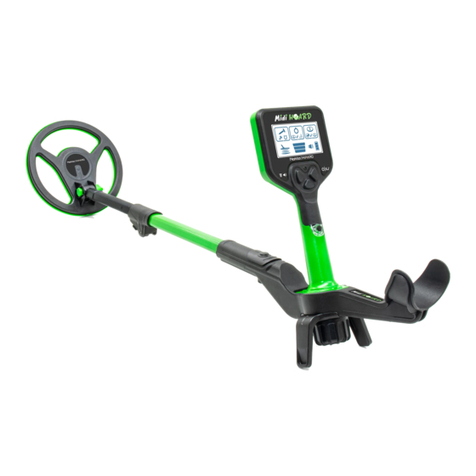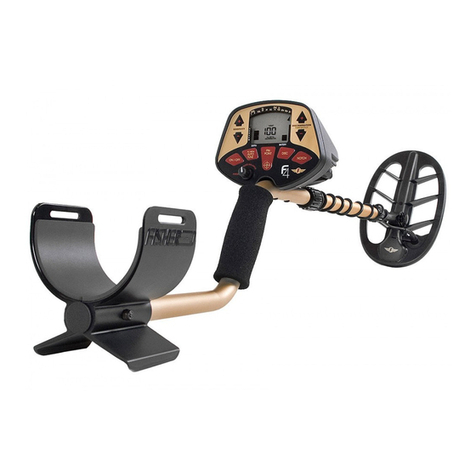Fisher Lab CZ-21 QuickSilver User manual

CZ-21 QuickSilver
Operating Manual
Deep Search, Land and Underwater, Target I.D. Metal Detector
FISHER RESEARCH LABS
FRL#8701931-
ATTENTION:
Damage do to neglect or accidental damage
is not warrantable
IMPACT WARNING:
Impact to the front knobs, the front edge, or
the case will cause the front plate to fracture,
resulting in leakage.
Such damage is not warrantable.
CABLE STRESS:
If you hip-mount the CZ-21, leave slack
in the cable so as not to pull cable taunt
at end of sweep.
Damage to coil cable at housing connection
is not warrantable if a result of repetitive,
excessive stress.
Copyright© 2008 by Fisher Research Labs, Inc.
All rights reserved, including the right to reproduce this book,
or parts thereof, in any form.
Published by Fisher Research Labs, Inc.
Fisher® is a registered trademark of Fisher Research Labs, Inc.
www.sherlab.com
1465-H Henry Brennan Dr., El Paso, TX 79936 • (915) 225-0333

CONTENTS
About Your Detector ..............................................................pg. 1
Condensed Operating Instructions ......................................pg. 3
Headphones ...........................................................................pg. 4
Assembly................................................................................pg. 5
Setting Up ................................................................................pg. 6
For Land or Shallow Water..................................................pg. 6
For Diving .............................................................................pg. 7
For Hipmounting..................................................................pg. 8
Control Panel ..........................................................................pg. 10
Turn on Procedure ..................................................................pg. 11
Ground Balancing ..................................................................pg. 11
Touch Pad............................................................................pg. 12
Bobbing................................................................................pg. 13
Search Modes.........................................................................pg. 15
Auto Tune.............................................................................pg. 15
Target I.D..............................................................................pg. 16
Searching on Land or in Shallow Water ...............................pg. 18
Searching Underwater ...........................................................pg. 21
Pinpointing ..............................................................................pg. 22
Target Identication ...............................................................pg. 23
Target Recovery .....................................................................pg. 27
Recovery Tools........................................................................pg. 28
False Signals............................................................................pg. 29
Battery Replacement .............................................................pg. 33
Maintenance ..........................................................................pg. 35
Battery Door Gasket: Orientation .........................................pg. 36
Where To Use Your Metal Detector In the U.S. .....................pg. 37
Specications .........................................................................pg. 38
Treasure Hunters’ Code of Ethics ..........................................pg. 40

1
ABOUT YOUR DETECTOR
Your CZ-21 QuickSilver is an all-purpose metal detector
engineered for land, beach, salt and fresh-water treasure hunters.
Here are some important features:
1. Leakproof: Submersible to 250 feet.
2. 3-Tone Target I.D.: A low tone for iron, a mid-tone for
pull tabs, foil and most gold rings, and a high tone
for U.S. coins, silver rings and some gold rings.
3. Depth: Patented Fourier domain signal analysis. Two
deep-seeking, ground-compensating VLF signals
(one at 5 KHz and one at 15 KHz) provide twice as
much target information for accurate analysis and
identication.
4. Two Search Modes: A silent running, slow motion
target I.D. mode and a hot, autotune mode for all-
metal searching.
5. VCO No-Motion Pinpointing: Tap the pinpoint button
and the audio tone increases in pitch and volume
as the center of the coil approaches the target.
6. Big-Target Alert: The CZ-21 circuits may overload
on large, shallow targets. A distinctive bell tone
immediately warns you that the target is too large
to identify.
7. Faint-Target Audio Boost: As you increase the volume
level past “5”, strong target sounds remain at a xed
volume while faint, deep-target sounds continue to
get louder.
8. Quick Manual Ground Balance: Tap the pinpoint
button and lower the coil to the ground. Then set
the ground control just below the audio tone and
you are precisely tuned for on-site conditions.
9. Separately Sealed Battery Compartment: Protects
the electronics from accidental ooding.
TREASURE HUNTERS’ CODE OF ETHICS
LET’S PRESERVE OUR TREASURED SPORT!
Laws governing the use of metal detectors are becoming
more and more common. In many countries, the use of metal
detectors is illegal or severely restricted. Don’t let this happen in
your area.
ALWAYS get permission to hunt on private property.
ALWAYS leave a site cleaner than you found it. Take at least
some trash with you or, if you can, take it all.
ALWAYS ll in your holes neatly whether you’re in a city park
or in a remote wilderness. Leave the land as it was before you
disturbed it.
ALWAYS obey all laws relating to treasure hunting.
ALWAYS return valuable property if you can locate the original
owner.
ALWAYS do whatever you can to give the hobby of treasure
hunting the good image it needs and deserves.
40

ABOUT YOUR DETECTOR
2
10. Search Coils: The CZ-21 comes with the 8” coil as
standard equipment, but can also be custom
ordered with the 10” coil. All coils are permanently
attached.
11. Balanced, ComfortableandHipmountable:Cushioned
arm rest, soft foam grip and a control housing that
slips off the handle and onto your belt.
12. Salt Water Compensation: Salt water is electrically
conductive, and therefore induces a strong
signal in the searchcoil. Unlike most other metal
detectors, the CZ-21 uses Fourier Domain signal
analysis to cancel the salt water signal. Under most
conditions you will not experience any false signals
from salt water. When working in the surf zone at
high sensitivity settings you may hear an occasional
“whisper” which is easily ignored.
13. Easy to Use: Just pick it up, set the control on the red
circles and start searching in a “coins-only” mode.
Or for maximum performance, adjust the controls
for your own specic situation.
Read this instruction manual thoroughly, practice often and
you’re in for some exciting treasure hunting. Drop us a line if you
have any questions, comments or good nds to tell us about. In
the meantime . . .
Happy Hunting,
Fisher Research Labs
39
Batteries.................... Separately Sealed Compartment........... Yes
................................... Type.......................................... (4) 9V Alkaline
................................... Life Alkaline ......................................35-55 hrs.
................................... Nicads10-20 hrs.
Operating Temperature ..... 32° - 110° F
Faint Target Audio Boost .... Yes
Manual Threshold Tuning.... In Autotune Mode
Target I.D. ............................. Three tones plus bell tone for large,
............................................... shallow targets, plus 7 preset DISC.
............................................... control settings
SPECIFICATIONS
Notes:
1. Subject to improvement or modication without notice.
2. Approximate.
3. Pulsegate Unipolar Audio Processing. Advanced Fisher circuitry which allows
silent operation below “audio threshold tone” with no loss in sensitivity.
4. The CZ-21 is a “motion” detector while in the search mode. The search coil
must be moving at least slightly to detect a target.
5. Electro-Static-Insulated to eliminate certain types of false signals.

3
CONDENSED OPERATING INSTRUCTIONS
Factory Pre-Set “Turn-On-and-Go” Marks
Your CZ-21 QuickSilver is simple to operate. Even so, we strongly
recommend that you read this entire manual. You’ll be able to
tune your CZ-21 to your specic needs and conditions.
1. Set all the controls to the red “Turn-On-and-Go”
pre-set:
GROUND = 5
DISC = 4
SENSITIVITY = 3
VOLUME = 5
This puts you in a “coins-only” mode, and you’re ready
to start searching. Keep in mind that the GROUND
setting of “5” is probably not the optimum setting
for the ground you’re searching. The sensitivity level
is set low to reduce false signals caused by ground
mineralization.
Pre-set Audio
Boost mark
at “5”
Salt-water Pre-set
SENSITIVITY at “3”
Pre-set
DISCRIMINATION
at “4”
Pre-set
GROUND at “5”
Figure 1. Factory pre-set turn-on-and-go marks (circled in red or
blue on your CZ-21 control panel) can get you up and running
immediately.
38
SPECIFICATIONS
Length ..................... Extended .................................................... 50”
................................... Collapsed ................................................... 30”
Weight
Complete (with headset)..............5 lb...11 oz. 6 lb...1 oz. 5.4 lb.
Handle and Search Coil.............. 2 lb...6.9 oz. 2 lb...12.9 oz. 2.1 lb.
Control Housing....................................................................... 2.8 lbs.
Frequency ............... 1. Dual, VLF Search 5 KHz and 15 KHz
................................... 2. Audio Target Response
Iron I.D. ..................... 200 Hz (Low tone)
Foil and Tab I.D. ...... 450 Hz (Mid tone)
Coin I.D. 1 KHz (High tone)
Autotune ................. 500 Hz - 1 KHz (VCO)
Pinpoint ................... 500 Hz - 1 KHz (VCO)
Operating Modes
1. Autotune ..... VLF-Motion, all-metal with threshold tone
2. Target I.D .............................................................VLF-Slow Motion,
............................................................... Silent Search Discrimination
3. Pinpoint .................................................VLF, All-Metal, No Motion
Search Coil............... Type ...........................Concentric, Co-Planar
................................... Diameter .................................. 8”, 10.5” or 5”
................................... Shielding ........................................... 100% ESI
................................... Interchangeable .......................................No
................................... Visual Target Response ..............Dual L.E.D.’s
Headset................................................... Waterproof, Piezo Electric
Interchangeable............................................................................No
Ground Balance .......................................... Touch Pad, Manual or
.................................................................. “Preset” Control Markings
Hipmountable Control Housing................................................... Yes
Salt Water/Fresh Water Operation .............................................. Yes
Land Operation............................................................................. Yes
Submersible....................................................................... to 250 feet
8” Coil 10.5” Coil 5”
Fresh-
water
sensitivity
Pre-set
at “7”

4
2. Adjust the volume control for a comfortable volume
when the coil is passed over a large, shallow
target.
3. Travel slowly, overlap your sweeps and keep the
search coil moving. Remember, you’re in a “motion”
search mode, and the coil must be in motion to
detect a target.
4. When you get a good, repeatable signal, pinpoint
the target.
CONDENSED OPERATING INSTRUCTIONS
Using headphones (not supplied) improves battery
life, and prevents the sounds from annoying
bystanders.
It also allows you to hear subtle changes in the
sound more clearly, particularly if searching in
a noisy location. For safety reasons, do not use
headphones near trafc or where other dangers
are present. This device is to be used with
interconnecting cables/headphone cables shorter
than three meters.
Using Headphones

5
ASSEMBLY
Submersible
Headphones
Control Housing
Target I.D. Decal
Foam Hand Grip
7-foot Search Coil Cable
Fiberglass Upper Stem
Arm-rest Screw
Battery Access Panel
8-inch
Spider
coil
Nylon
Wing Nut
Fiberglass Reinforced
Nylon Lower Stem
Headphone
Plug
Adjustable Arm Rest
Your Fisher CZ-21 requires little assembly. Handle it carefully, care
for it regularly, and it will give you years of dependable service.
1. Remove the headphone, handle and search coil
assemblies from the box. Be careful not to put any strain
on the cable connections.
2. Adjust the lower stem to the approximate length you
will be using: extended for stand-up use or as short as
possible for diving. To extend the lower stem, push in the
spring lock, pull out the lower stem and let the spring lock
snap into another hole.
3. Unwind just enough cable to attach the search coil to
the lower stem.
4. Remove the bolt and wing nut from the search coil. Line
up the hole in the lower stem between the two holes in
the search coil “ears.” Attach the coil to the stem with
the bolt and wing nut and nger tighten.
5. The arm rest may be repositioned for maximum comfort
by removing the arm-rest screw, sliding the arm rest to the
next screw hole and re-inserting the arm-rest screw.
Control Panel
Figure 2. CZ-21 Quicksilver Detector.

6
SETTING UP FOR LAND OR SHALLOW WATER
Put the headphones around your neck to keep them out of
the way while making the following adjustments:
1. Adjust the stem length and coil angle so the search
coil rests at on the ground about 6 inches in front
and slightly to the right of your foot (to the left of your
left foot if you’re left handed).
2. Leave enough slack in the coil cable to allow the
coil to swivel as far as it can in either direction. The
coil wing nut should be tight enough to prevent the
coil from moving.
SETTING UP
ASSEMBLY
Figure 4.
When searching on land
or in shallow water, keep
your arm straight and your
search coil no more than 2
inches above the ground.
Adjustable Arm Rest
Figure 3. Screw
Screw Hole
Upper Stem

7
Control housing
Shortened stem length
Extra, coiled
cable
3. You should now be able to move into your “search”
position by leaning slightly forward and raising the
search coil no more than 2 inches above the ground.
Your arm should still be straight, and the coil should
be parallel to the ground, about 12 inches in front
of your foot. The coil angle may have to be slightly
readjusted at this point.
SETTING UP FOR DIVING
Unlike most VLF metal detectors, the CZ-21 works well in salt
water. This capability, along with its deep-seeking sensitivity, makes
it ideal for underwater treasure hunting and wreck diving. The CZ-21
is waterproof to a depth of 250 feet. Remember, always practice
safe diving methods.
When diving with your CZ-21, use the shortest stem length
possible, with the extra cable wrapped tightly around the stem,
as closely as possible to the control housing. Never hipmount your
control housing while diving.
1. Adjust the stem length as short as you can without having
the search coil detect your diving gear.
2. Adjust the search coil parallel to the sea bed, river or
lake bottom.
3. Make sure extra cable is coiled tightly on the upper stem
as closely as possible to the control housing, with just
enough slack near the search coil to allow it to swivel
as far as it can in either direction. Too much loose cable
near the search coil may generate false signals.
4. Remove the tethered earphone plugs for rapid pressure
equalization as you dive and return to the surface.
SETTING UP
Figure 5.

8
Caution: Hipmounting the CZ-21 control housing is not
recommended for underwater use. The search coil cable may
become entangled with a submerged object, making it difcult
for the diver to resurface quickly in case of emergency.
SETTING UP FOR HIPMOUNTING
For nearly-effortless treasure hunting, the control housing is
easily removed from the handle and attached to the belt clip
(included).
INSTRUCTION FOR REMOVAL OF CZ-21 FROM HANDLE
WARNING DO NOT DO THIS
Do not push on unit from the back (battery side.). Doing this will
most likely cause unit to release suddenly and y off, impacting
on the control knobs on the oor, and damaging the unit.
THIS TYPE OF DAMAGE WILL VOID YOUR WARRANTY
SETTING UP
Figure 6. You can hipmount your CZ-21 by sliding the control housing from
the handle and attaching it to your belt. This reduces the weight of the
stem, creating nearly effortless hunting.

9
Hold unit rmly and separate handle, being careful not to drop
the control unit and damage it. Place unit battery side down with
battery cover on table top, or a at stable surface and grasp the
unit rmly in one hand and the handle grip rmly in the other.
“Hipmounting” the CZ-21 in this manner takes about half the weight
off the handle and allows the land or shallow-water treasure hunter
to search much longer without arm fatigue.
1. Slide the belt clip into grooves on the bottom of the
control housing. This is a snug t, and you’ll have to
bend the clip slightly.
2. Unwrap just enough of the coil cable to allow for
searching.
3. Slip the control housing onto your belt, left side for
right handers, right side for left handers.
NOTE: Because of the extreme sensitivity of the CZ-21 search coil,
hipmounting the control housing may produce a false signal when
the search coil reaches the end of its arc (on the side that the
control box is attached to your belt). Depending on your stem
length and how high you have the housing hipmounted, the
search coil may actually detect the housing.
WARRANTY NOTICE:
Damage to coil cable at housing connection is not warrantable if
damaged by excessive force.
If hipmounting, please leave slack in the cable so as not to yank
the cable from the housing at the end of your sweep.
SETTING UP

10
1
2
5
3
4
CONTROL PANEL
1. VOLUME/OFF: Power on-off and volume control.
Volume is gradually increased from 1-5 settings. From
5-10, loud-target response is held constant while faint
targets continue to get louder.
2.
DISC: In the 0-6 positions, the CZ-21 is in the target I.D.
mode, which is a silent, no-threshold, motion-discrimination
mode of operation with the ability to identify and then
ignore (“reject”) or accept many kinds of small metal
targets. In the AUTOTUNE position, the CZ-21 is in an all-
metal mode. In this mode, the CZ-21 has a slightly wider
and deeper search pattern, however, it lacks the ability
to discriminate or identify and reject targets.
3. GROUND: Used to electronically cancel the effects of
ground mineralization. Proper use of this control will
minimize false ground signals and ensure that the CZ-21
is operating at its maximum potential in just about any
ground condition including wet ocean sand.
4. SENS (Sensitivity)/BATT TEST:
SENSITIVITY: The higher the setting, the more sensitive
the detector. Start at lower sensitivity setting until you
gain experience with the detector. lis the suggested
default setting for salt water hunting. pis suggested
for fresh water.
BATT TEST: To test batteries
1. Reduce volume to low level
2. Put on headphones
3. Rotate SENS knob to BATT TEST position
4. Rotate VOLUME knob to increase volume
As you rotate to “10” the volume and tone will indicate
Figure 7.
Control Panel
31
FALSE SIGNALS
6. Wet Salt Water Sand: Your CZ-21 should be able to
handle most wet sand easily unless it’s black. See
Black Sand above. You should able to reduce the
number of false signals caused by salt water by
lowering your sensitivity and making sure you are
ground balanced properly.
7. Hot Rocks: Some rocks, by virtue of their high mineral
content, will be seen by metal detectors as a metal
target. In the Autotune mode, the CZ-21 will respond
to most hot rocks. Prospectors must learn to distinguish
between hot rock and nugget sounds. In the
target I.D. mode, certain types of hot rocks will be
automatically rejected at DISC = “0” and virtually all
other hot rocks will be identied as iron or rejected
at DISC = “1.”
8. “End of Swing:” Silent search motion detectors often
give false signals at the edges of the search pattern,
just as the coil stops and begins accelerating back
toward the operator. If this is a problem, try one or
more of the following:
a) Keep your sweep smooth, slow and low to the
ground.
b) Check your ground balance.
c) Lower your sensitivity.
d) Make sure your search coil is properly secured
and the cable connector is rmly tightened.
9. Digging Tool: If you’re carrying a metal sand scoop,
digging knife, or screwdriver, hold it behind your back
or keep it above your waist. Your CZ-21 is sensitive
enough to sound off each time you sweep the coil
beneath it.
10. Elongated Ferrous Objects: If you get two beeps
close together and can’t nd either target, you may
be near a nail or some other long, ferrous object.
Fortunately, in most cases your CZ-21 will identify
these objects correctly. In all cases, the target will be
between the beeps, or if you sweep at right angles

11
When your CZ-21 QuickSilver is properly “ground balanced,”
it will have only a minimal response to ground mineralization.
Precise adjustment of the GROUND control is critical for optimum
performance. The higher the degree of ground mineralization or
the higher the sensitivity setting, the more critical it is to have your
machine properly ground balanced. Once you adjust it in either
the Autotune mode or Target-I.D. mode, you can switch back and
forth between the two modes without resetting. Recheck your
setting occasionally as you search because ground conditions
often change rapidly.
If you have difculty ground balancing, try reducing your sensitivity
level or moving to another spot just in case you are over a buried
piece of metal. In some areas of high ground mineralization you
may not be able to use the touch pad method.
battery strength.
GOOD BATTERIES: Loud, high pitched tone
WEAK BATTERIES: Soft, low pitched tone or “ticking” sound
BATTERIES NEED REPLACING: No tone
During use, the speaker volume will fade and become
nearly inaudible before the detector performance is
compromised by weak batteries.
5. PINPOINT: Activating the PINPOINT feature withthe center-
positionedbuttonentersaNO-MOTIONdetectionmode.In
this mode of operation, the detector will emit a monotone
hum whenever metal enters the coil’s eld of detection.
To use pinpoint, PRESS the button. The pinpoint button will
not deect with pressure; you will feel no movement in
the button. A 2nd press of
the button will return you
to your previous motion
detection mode.
A moderate pressure,
applied briefly to the
center of the button, is
required.
The button requires a
2-second wait between
presses.
GROUND BALANCING
CONTROL PANEL
30
I.D. location, your target is probably a piece of iron.
Reducing your sensitivity level, taking shorter, slower
sweeps, or increasing the discrimination level may
reduce the number of false signals caused by trash.
2. Deep Targets: Deep targets, just barely within
the range of the CZ-21, may be misidentied. For
example, a deep coin may I.D. as iron, or a deep
piece of iron may I.D. as a coin. There’s not much you
can do to avoid this other than to use your pinpoint
mode to ensure that you are exactly centered over
the target. Or you may reduce your sensitivity level
so you just ignore the very deepest targets.
3. Electrical Interference: Constant chatter caused by
radio/TV stations, power lines or nearby detectors
operating at one of the CZ-21 search frequencies.
The best solution is to move away from the source
of the interference. You may also try one of the
following:
a) switch to the Autotune mode.
b) reduce your sensitivity level.
c) slow down your sweep speed.
If the interference is only minimal and you wish to
continue searching anyway, test your CZ-21 over a
known target to make sure it’s operating properly.
Inside some buildings, electrical interference may be
so bad that you’ll have to go outside just to bench
test your CZ-21.
4. Highly Mineralized Soil: May cause a bell tone
response or constant false signals. Check your
ground balance (See page 11). Try lowering the
sensitivity and/or increasing the discrimination level.
Search in the AUTOTUNE mode. Re-ground balance
using the “bobbing” method (See page 13). If all
else fails, raise the search coil just high enough for
the false signals to disappear and then sweep at
that constant height.
5. Black Sand: Same as Highly Mineralized Soil
above.
FALSE SIGNALS

12
QUICK G.B. METHOD
This will probably be your method of choice in all but the most
difcult of ground conditions. It’s fast, easy and accurate. You can
use this method in either the Autotune or Target-I.D. mode.
1. With GROUND control at “10” hold your search coil
6 to 12 inches off the ground. Make sure you’re at
least 3 feet away from any metal objects.
2. Tap the PINPOINT button and lower the search coil to
the ground. Rotate the GROUND control clockwise
until you hear an audio tone. Then back off to the
exact point where the tone disappears.
3. Always ground balance your CZ-21 in the areas
you intend to search, whether it’s on land or
underwater.
NOTES:
1. If you get an audio response as you rst lower the coil with
the GROUND control at “10,” you’re probably over a piece
of metal. Move and try again.
2. If you get a sudden bell tone that is not preceded by an
increasing audio response as you lower the coil, you’re
probably in some very highly mineralized soil or sand. In this
case, it’s best to use the “bobbing” method.
3. If you don’t get any audio response, or just a very faint one as
you rotate the GROUND control from “10” all the way to “0,”
you’re probably in an area where there’s very little ground
mineralization. Just leave the GROUND control at “10” and
begin searching.
GROUND BALANCING
29
FALSE SIGNALS
A “false signal” occurs when a target is incorrectly identied. For
example , a small, broken-off piece of pull tab may be identied
as a nickel. Or a small, deep coin, especially in mineralized soil,
may read “IRON.” The more sensitive the metal detector, the
harder it is not to have false signals. Your CZ-21 is an extremely
sensitive machine, so you’re bound to encounter them. Here are
some of the most frequent sources of false signals and what to
do about them:
1. Trash: The most common source of false signals.
Large or irregular pieces of trash may give good,
consistent, high-tone signals. In this case you’ll usually
have to dig the target, but with experience you’ll be
able to eliminate many of the large targets whose
size will be obvious when you go into the pinpoint
mode. Another false signal response may be a “one-
way” or disappearing signal. You’ll sweep over the
target and get a good signal but nothing on the
return sweep. When this happens you’re over a
target that the CZ-21 can’t positively identify due
to its size, shape, depth or alloy. The CZ-21 may I.D.
it as a coin when swept from one direction and iron
on the return sweep.
If your DISC control is set at “0” you’ll hear rst
a high tone (coin) and then a low tone (iron). Or if
your DISC control is set higher, to reject iron, you’ll
hear the high tone sweeping one way and nothing
the other way.
Quite often the signal will just disappear and you
won’t be able to nd it no matter which direction you
sweep. These one-way and disappearing signals are
usually trash, and as a general rule you should ignore
them. If you have any doubts, tap the PINPOINT
button to get an accurate location, and then I.D. the
target. If you get a good repeatable tone, dig it. If you
still get a one-way signal or it disappears, move on.
Also, if your pinpointing location is different than your

13
BOBBING METHOD
1. Turn disc knob to “AUTOTUNE”, this puts you into
Autotune mode. Set the “SENSITIVITY” control so that
you just barely hear a threshold hum.
Hold the search coil 6 to 12 inches over the ground
and at least 3 feet away from any metal objects. Do
not use the PINPOINT button during any part of this
procedure.
2. Lower the coil an inch or two above the ground and
then quickly raise it. Note that as you lower the coil,
the tone disappears then gets louder as you raise it
and nally returns to normal when you stop it 6 to 12
inches above the ground. Conversely, if you set the
GROUND control to “1,” the threshold hum will get
louder as you lower the coil and disappear when
you raise it.
3. Your objective now is to adjust the GROUND control
so that there is no change, or only a minimum
change in the threshold hum, as you move the coil
up and down. Start by lowering the GROUND control
to “9.” Lower the coil and raise it again. One of three
things will happen to your threshold hum:
a) It will fade again as you lower the coil and
increase as you raise it. Continue to lower the
ground balance setting in small increments until
the threshold hum remains the same (or changes
very little) as the coil is lowered and raised.
b) lt will get louder as you lower the coil and go
silent as you raise it. You have gone past the
correct ground-balance setting. Increase the
ground-balance level (rotating the control
counterclockwise) in small increments until there
is little or no change in the threshold level.
c) The hum will remain the same, or if it changes
slightly, the change is the same whether you
lower or raise the coil. Your CZ-21 is properly
ground balanced, and you are ready to begin
searching.
GROUND BALANCING
28
RECOVERY TOOLS
1. Sand scoops designed especially for beachcombers
and shallow-water treasure hunters are available at
metal detector outlets.
2. Divers use a variety of recovery tools, depending
on the condition of the sea bed or lake bottom. A
sturdy dive knife will sufce in packed mud or small
rocks. Most divers prefer to use their hands in loose
sand. Professional treasure hunters often use an air
hose fed by a surface compressor to blow away
loose sand, gravel or mud.
3. For land recovery, a sturdy hunting knife with a 5-inch
blade will sufce in most soils. A high quality, double
edged “survival” knife is an even better choice (and
more expensive) because it will be almost impossible
to bend or break.
CAUTION: Using a jack knife without a locking blade
is a good way to lose a nger.
4. A heavy duty, blunt screwdriver is commonly used
for shallow targets where digging or “plugging” is
objectionable.

14
GROUND BALANCING
4. With a little practice, you should be able to ground
balance quickly by “bobbing” the coil up and
down in a continuous movement as you adjust the
GROUND control with your thumb.
NOTES:
1. If you get an audio response as you rst lower the coil with
the GROUND control at 10, you’re probably over a piece of
metal. Move and try again.
2. lf you get a sudden bell tone, not preceded by an increasing
audio response, you’re probably in some very highly
mineralized soil or sand. Instead of lowering the coil to an inch
or two above the ground (as in step 2 above), stop just before
you hear the bell tone and ground balance as instructed.
Maintain that coil height as you search.
3. If you don’t get an audio response, or if the hum stays the
same no matter where you set the GROUND controls as
you bob the coil up and down, you’re probably in an area
where there’s very little ground mineralization. Just leave the
GROUND control at “10” and begin searching.
4. Recheck your ground balance occasionally.
27
TARGET RECOVERY
Once you’ve identied and pinpointed a target, your objective
is to recover it quickly and neatly, leaving virtually no trace of your
excavation. There are almost as many ways to do this as there are
treasure hunters. Whatever works for you is good enough as long
as you don’t break any laws, leave uncovered holes or damage
the environment either on land or underwater.
Generally speaking, divers and beachcombers do little, if any,
damage to the environment while recovering small targets.
However, if you plan to use your CZ-21 on lawns or in parks, your
target-recovery method can be very important.
POINTS TO REMEMBER
1. When in doubt, dig. If your CZ-21 can’t quite decide
whether a target is good or bad, dig it up.
2. Good things often come in two’s. Or even three’s.
Once you’ve recovered a good target, always
recheck the hole for a second signal and carefully
search the immediate area by walking slowly
around the hole two or three times, overlapping your
sweeps in an ever-widening circle. Always dig every
suspicious sound in the vicinity of a good nd.
3. Recheck your hole even if your nd was trash. Good
targets are often found beneath bad ones.
Whichever method you choose, remember that responsible treasure
hunters take pride in their ability to leave soil and vegetation intact
and undamaged. If you don’t want to see your right to treasure
hunt restricted or even eliminated by government legislation, ll
those holes and leave your hunting areas in better shape than
when you arrived!

15
SEARCH MODES
Your CZ-21 has two search modes: Target I.D. and Autotune. Both
search modes are “motion” modes, meaning the search coil must
be in motion to detect a target. Unlike other metal detectors, the
discrimination level has little, if any, effect on the depth capability
of the CZ-21. Note, however, that the all-metal Autotune mode has
a wider search pattern and may detect a little deeper. Depth is
also determined by the size, shape and conductivity of the target
as well as the sensitivity setting of the CZ-21.
AUTO TUNE MODE
Set the DISC control to AUTOTUNE, for a very sensitive, wide-
scan, all-metal, motion search mode. This mode responds to all
metal targets and does not have the ability to identify or reject
objects.
The Autotune mode is useful in three situations:
1. Non-Trashy Areas. The Autotune mode has a wider
scan than the I.D. mode, reducing changes of
missing good targets. Search in the Autotune mode
until you nd a target. Pinpoint the target using the
PINPOINT button and then switch the DISC control
to “0” to identify the target in Target I.D. mode. The
DISC control is positioned so that you can switch back
and forth between AUTOTUNE and “0” with a ick of
your thumb.
2. Highly Mineralized Soil or Sand. The Autotune mode
is recommended for black and gray beaches or
highly mineralized soil. Under these conditions it
may be necessary to lower the sensitivity level and
sweep several inches off the ground (see the notes
on p. 14) Gold nuggets are generally found in highly
mineralized soil so this will be the search mode of
choice for prospectors.
3. All Metals Searching. Evidence recovery teams,
archeologists and professional underwater treasure
hunters will often opt for the deep search, all-metals
Autotune mode.
26
a feel for which target classications will be the most
productive.
13. Look for repeatable signals and don’t waste time
on disappearing or one-way signals. If you hear a
good beep but can’t repeat it when you go back
over the target area, or if it beeps in only one sweep
direction, it’s probably a piece of trash - something
below your discrimination setting.
14. If you’re in a relatively non-trashy area, try searching
in the Autotune mode and then identifying your
targets by switching to DISC = “0.” You’ll nd more
and deeper targets this way. And you’ll eliminate
almost all false signals. If you’re having any difculty
pinpointing or identifying a target in the I.D. mode,
don’t waste any more time. Push the pinpoint button
for quick pinpointing, then release it for accurate
I.D.
15. If your target disappears when you go into the Pinpoint
mode, you’ve probably tuned it out by pressing the
button too close to the target or over another piece
of metal. Try again, this time tapping the PINPOINT
button over another piece of ground.
16. Don’t waste a lot of time digging holes for targets
you can’t nd. If your hole keeps getting deeper
and wider, cover it up and go on. You may be over
a buried pipe or some other large deep target.
TARGET IDENTIFICATION

16
TARGET I.D. MODE
When the DISC control is set in the 0-6 positions, the CZ-21 has
the ability to identify many types of small targets and, depending
on the discrimination level, reject or ignore most of them. To better
understand just how your CZ-21 responds to different targets, try
the following:
1. Scatter some sample targets such as coins, rings, pull
tabs, nails and foil on the ground at least 18 inches
apart. Include some large targets as well: jar lids, soda
cans, etc.
2. Set the DISC control at “0,” SENS at “5.” Adjust the
VOLUME control for a comfortable level when you
are over a large target.
3. Ground balance the CZ-21 as in the “Ground
Balance” procedure.
4. Hold the search coil about 2 inches above and
parallel to the ground and move it slowly back and
forth across each sample. Remember, the coil must
be in motion to get a response. Keep in mind that
for accurate target I.D., the coil center must pass
directly over the target.
5. Note the different audio responses over the various
targets. Your CZ-21 will respond with a low tone over
most iron or steel targets. Pull tabs and foil will give a
medium-tone response. U.S. coins give a high tone
response.
6. Note that an elongated ferrous object such as a nail
will give you a double “beep” as you cross it from end
to end, or a single “beep” if you cross its center.
7. The signal from a large or shallow target will overload
the circuit, making target identication impossible.
The CZ21 indicates this condition with a distinctive
bell tone. The overload will not harm the detector;
the signal is just too strong for interpretation. If you
hear the bell tone, indicating overload, move the
searchcoil away from the target. Sweeping at
a greater distance may allow for proper target
identication.
SEARCH MODES
25
may fall into just about any category, the smaller
nuggets falling on the lower half of the scale. So if
you’re not just looking for U.S. coins, you should test
some sample targets to determine what level of
discrimination you want to work at and what targets
you want to dig.
10. Here’s a quick and easy way to tell the difference
between a small, shallow piece of foil and a gold
ring (or other possibly good target) without digging:
If you get a good solid “FOIL” I.D., set the search
coil down close to the target and then whip it
rapidly across the target just once with what can
best be described as a ick of the wrist. lf the target
disappears, it’s probably a small, shallow piece of
foil. If not dig it up it could be that gold ring you’re
looking for. Practice this over some foil until you get
the hang of it.
11. Don’t be afraid to turn your sensitivity down. True,
the higher the sensitivity, the deeper your CZ-21 will
go, and the more you’ll nd. But that’s only under
optimum conditions. If you’re getting a lot of false
signals caused by electrical interference, ground
mineralization or dense trash, lower your sensitivity.
If you have to back it down to “4,” “3” or even
“2” to eliminate the falsing, do it. That’s what your
SENSITIVITY control is for. You’ll be surprised at how
much you might nd in an area that would otherwise
be unsearchable at high sensitivity levels.
12. Set your discrimination at an appropriate level. If
there’s very little trash in the area, set it low, say
at iron discrimination, and dig every good signal.
If there is a lot of trash present and you’re mainly
interested in coins, set the discrimination level high.
You may even want to sacrice nickels and zinc
pennies in extremely trashy areas. If you’re looking
for gold rings, relics, artifacts, or small ancient coins,
you’ll have to set your discrimination level low. The
best way to nd out how low is to bury some sample
targets or just dig everything for awhile until you get
TARGET IDENTIFICATION

17
SEARCH MODES
8. Most silver rings will give a high tone. Most gold rings
will fall into the pull tab/foil mid-tone category. This is
due to the unavoidable fact that most gold rings are
conductively similar to aluminum foil and pull tabs.
Some are more closely identical to the U.S. 5-cent
piece; however, the CZ-21 does have the unique
ability to separate those signals from the aluminum
trash signals.
9. Now increase the DISC control to “1.” You will nd
that the CZ-21 rejects the small, iron targets and no
longer responds with an audio tone.
10. Continue to increase your DISC control, noting
that with each successive step up, more and more
targets are rejected. At DISC = “4” for example, a
“coins-only’ mode will ignore iron, tabs and foil while
accepting U.S. coins.
11. The target I.D. decal on the left underside of the
control housing graphically displays which items
are rejected and accepted at each DISC level. For
example, “foil” is placed between DISC = “2” and
DISC = “ 3.” This means that foil is accepted at “2”
Figure 8. Typical CZ-21 Audio Responses
24
TARGET IDENTIFICATION
coin.
5. The DISC control provides increments of rejection and
identication within the mid- and high-tone target
classications. Take a look at the target I.D. decal
on your control housing to see what gets rejected
at which DISC point.
6. If you’re getting a high-tone response for example,
you may well be over a U.S. coin. If you want to know
what kind of coin it is, advance the DISC control to
“5.” You know from the I.D. decal that if you lose the
signal your target is probably a nickel (or something
conductive and very similar). If you don’t lose it, go
up to “6.” If you lose it at “6,” your target may well be
a U.S. zinc penny. If you still get a signal, your target, if
it is indeed a coin, will probably be a copper penny,
an older silver coin or a clad coin. Most other small
targets will be ignored.
7. The same is true of the mid-tone targets: Round pull
tabs are rejected at “2,” foil at “3” and rectangular
tabs at “4.” If, for example, you’re looking for gold
rings in an extremely trashy area, you have the ability
to reject at least some of the trash (like iron, round
tabs and foil) and still get those rings falling into the
rectangular tab and all coin categories. Of course
you’ll have to dig rectangular tabs as well.
8. Your CZ-21 will correctly identify most of the targets on
your I.D. decal most of the time, but it can be fooled.
Large targets, uneven ground mineralization, good
targets lying next to bad targets, deep targets, all
of these and more are sources of error. Remember,
the CZ-21 is designed to I.D. small, coin-sized targets
only, and even some of these may be deep enough,
bent, damaged, or corroded enough to give a false
signal.
9. You should also realize that there are many good
targets which are not classied by the CZ-21, as
mentioned earlier. Gold rings, for example, may fall
into any category except iron. Many foreign coins,
especially the new ones, may I.D. as foil or pull tab.
Gold nuggets, depending on their size and shape,

18
and rejected at “3.”
12. You may expect varying signals over different targets
and at different levels of discrimination. Note that as
you progressively increase the discrimination level,
more and more targets are eliminated.
13. Now switch the DISC control to the AUTOTUNE
position and note the completely different kind of
response. No tone, just a smoother, solid response
over every target.
Good search technique is very important to successful treasure
hunting.
1. Make sure your CZ-21 is properly ground balanced.
2. Decide which search mode you’re going to use.
Target I.D. is the recommended starting point with
the DISC control set at “4” or Autotune.
3. Set your SENSITIVITY control. Only experience will tell
you how to set it in every situation, but you’ll probably
want to run it as high as you can. Recommended
starting point: SENSITIVITY = “5.” If you’re in the
Autotune mode, set it so that you can just barely hear
a slight audio hum.
4. Adjust your VOLUME control. Remember that a setting
above “5” will amplify the response of faint targets so
that they sound like a shallow or large target. Some
searchers prefer not to use it above “5” so that the
audio response corresponds directly to the depth
SEARCHING ON LAND OR SHALLOW WATER
SEARCH MODES
23
Target I.D. with the CZ-21 is quick and simple. Just keep in mind
these two rules:
1) You must be in the Target I.D. mode.
2) The center of the search coil must pass directly over the
target.
It’s always a good idea to walk slowly and overlap your sweeps.
But if you’re searching a large expanse of new territory, you may
want to walk a little faster and not overlap your sweeps as much
until you start making a few good nds. Then, slow down, overlap
your sweeps and cover every inch of ground.
In trashy areas, to reduce the “masking” effects of trash on
nearby good targets, use a shorter and slower sweep pattern.
1. Once you’ve located a target, pinpoint its exact
location as in the “Pinpointing” procedure. Since
accurate I.D. is dependent on accurate pinpointing,
it is recommended that you tap the PINPOINT button
rather than try to pinpoint your target in either the
Autotune or Target I.D. mode.
2. Once you’ve pinpointed your target, tap the
PINPOINT button again. If you’re searching in the
Autotune mode, switch over to DISC = “0.” If you are
already in the Target I.D. mode, just leave the DISC
control where it is.
3. Move the coil just enough, left-right-left, across the
target to get a good, solid signal. If you no longer
get a signal after you’ve pinpointed your target,
then you’re over something that falls below the DISC
setting you’ve chosen, and your CZ-21 is rejecting
it.
4. Once you’ve pinpointed your target and you’re
getting a good, consistent signal, you’ve identied
or at least classied your target. A low tone means
your target is probably ferrous. A mid tone indicates
a pull tab or foil, and the high tone indicates a U.S.
TARGET IDENTIFICATION
PINPOINTING
Table of contents
Popular Metal Detector manuals by other brands
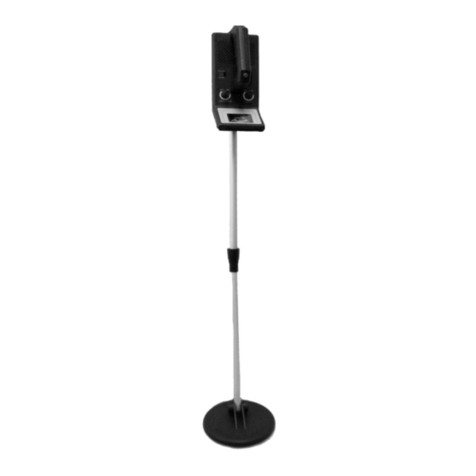
Harbor Freight Tools
Harbor Freight Tools 43150 Assembly and operating instructions

Harbor Freight Tools
Harbor Freight Tools 62307 Owner's manual and safety instructions
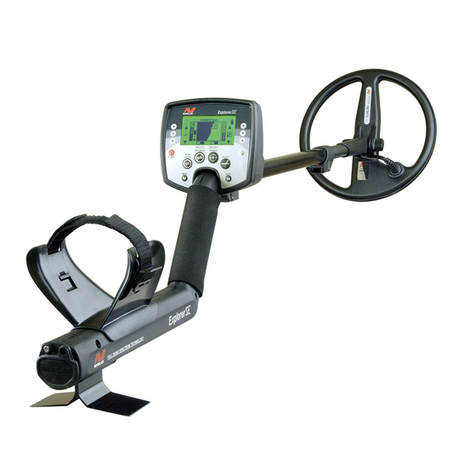
Minelab
Minelab Explorer SE quick start guide

Treasure Cove
Treasure Cove Vibra-Probe 585 manual
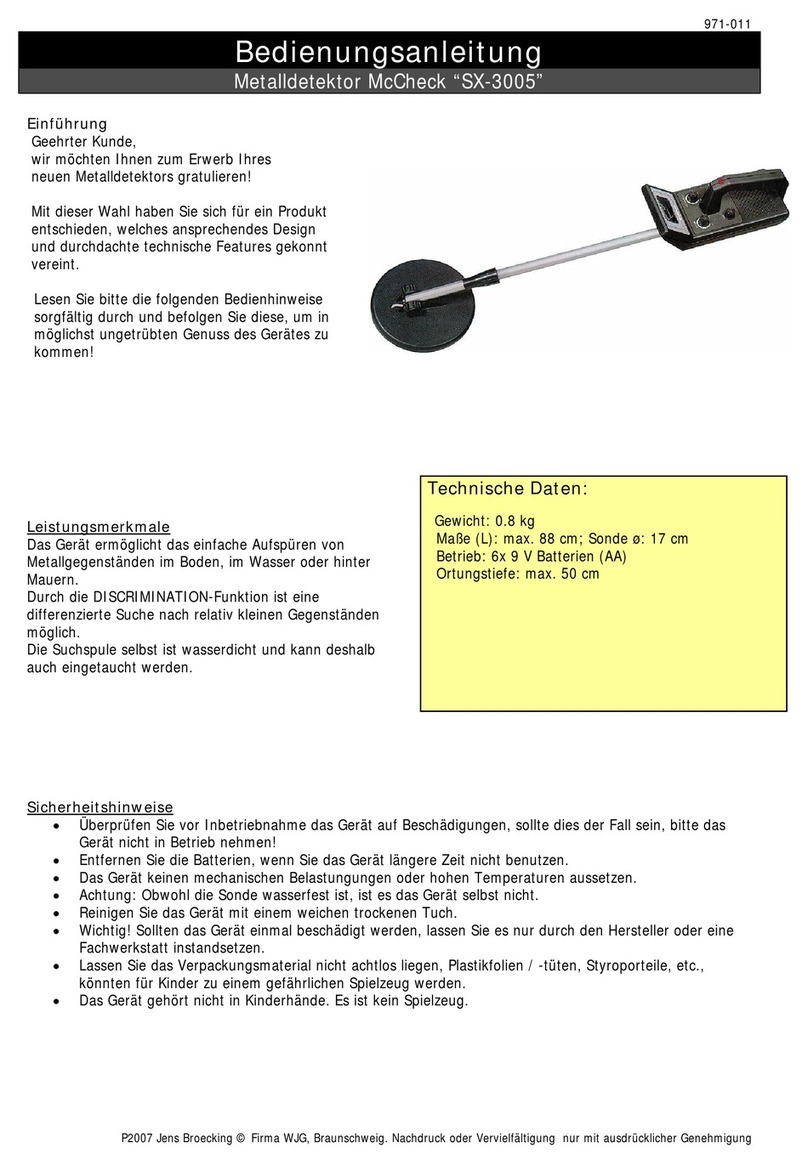
McCheck
McCheck SX-3005 Reference manual

Fisher
Fisher ID EDGE operating manual

